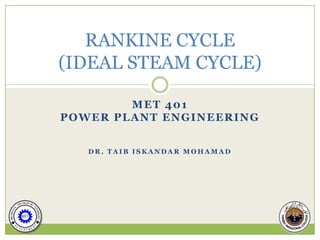
Rankine Cycle (Ideal Steam Cycle
- 1. RANKINE CYCLE (IDEAL STEAM CYCLE) MET 401 POWER PLANT ENGINEERING DR. TAIB ISKANDAR MOHAMAD
- 2. Rankine cycle Many of the impracticalities associated with the Carnot cycle can be eliminated by superheating the steam in the boiler and condensing it completely in the condenser. The cycle that results is the Rankine cycle, which is the ideal cycle for vapor power plants. The ideal Rankine cycle does not involve any internal irreversibilities. 2
- 3. Rankine cycle energy analysis Steady-flow energy equation The thermal efficiency can be interpreted as the ratio of the area enclosed by the cycle on a T-s diagram to the area under the heat-addition process. 3
- 4. Example 1 Consider a 210-MW steam power plant that operates on a simple ideal Rankine cycle. Steam enters the turbine at 10 MPa and 500°C and is cooled in the condenser at a pressure of 10 kPa. Show the cycle on a T-s diagram with respect to saturation lines, and determine (a) the quality of the steam at the turbine exit, (b) the thermal efficiency of the cycle, and (c) the mass flow rate of the steam. Answers: (a) 0.793, (b) 40.2 percent, (c) 165 kg/s Repeat the problem if the isentropic efficiencies for both pump and turbine equal 85 percent. 4
- 5. Example 2 Consider a coal-fired steam power plant that produces 300 MW of electric power. The power plant operates on a simple ideal Rankine cycle with turbine inlet conditions of 5 MPa and 450°C and a condenser pressure of 25 kPa. The coal has a heating value (energy released when the fuel is burned) of 29,300 kJ/kg. Assuming that 75 percent of this energy is transferred to the steam in the boiler and that the electric generator has an efficiency of 96 percent, determine (a) the overall plant efficiency (the ratio of net electric power output to the energy input as fuel) (b) the required rate of coal supply. Answers: (a) 24.5 percent, (b) 150 t/h 5
- 6. Example 3 Consider a 210-MW steam power plant that operates on a simple Rankine cycle. Steam enters the turbine at 10 MPa and 500°C and is cooled in the condenser at a pressure of 10 kPa. Show the cycle on a T-s diagram with respect to saturation lines, and determine (a) the quality of the steam at the turbine exit, (b) the thermal efficiency of the cycle, and (c) the mass flow rate of the steam. In this problem, the isentropic efficiencies for both pump and turbine equal 85 percent. 6
- 7. Example 4 Geothermal resource exists as saturated liquid at 230°C. The geothermal liquid is withdrawn from the production well at a rate of 230 kg/s, and is flashed to a pressure of 500 kPa by an essentially isenthalpic flashing process where the resulting vapor is separated from the liquid in a separator and directed to the turbine. The steam leaves the turbine at 10 kPa with a moisture content of 10 percent and enters the condenser where it is condensed and routed to a reinjection well along with the liquid coming off the separator. Determine (a) the mass flow rate of steam through the turbine (b) the isentropic efficiency of the turbine (c) the power output of the turbine (d) the thermal efficiency of the plant (the ratio of the turbine work output to the energy of the geothermal fluid relative to standard ambient conditions). Answers: (a) 38.2 kg/s, (b) 0.686, (c) 15.4 MW, (d) 7.6 percent 7
- 8. Deviation from ideal cycle The actual vapor power cycle differs from the ideal Rankine cycle as a result of irreversibilities in various components. (Fluid friction and heat loss) Isentropic efficiencies (a) Deviation of actual vapor power cycle from the ideal Rankine cycle. (b) (b) The effect of pump and turbine irreversibilities on the ideal Rankine cycle. 8 8
- 9. Example 5
- 10. Carnot Cycle The Carnot cycle is the most efficient cycle operating between two specified temperature limits. 1-2 isothermal heat addition in a boiler 2-3 isentropic expansion in a turbine 3-4 isothermal heat rejection in a condenser 4-1 isentropic compression in a compressor T-s diagram of two Carnot vapor cycles. 10 10
- 11. Impracticality of Carnot Cycle The Carnot cycle is not a suitable model for power cycles. Because: Process 1-2 Limiting the heat transfer processes to two-phase systems severely limits the maximum temperature that can be used in the cycle (374°C for water) Process 2-3 The turbine cannot handle steam with a high moisture content because of the impingement of liquid droplets on the turbine blades causing erosion and wear. Process 4-1 It is not practical to design a compressor that handles two phases. The cycle in (right) is not suitable since it requires isentropic compression to extremely high pressures and isothermal heat transfer at variable pressures. 11 11
